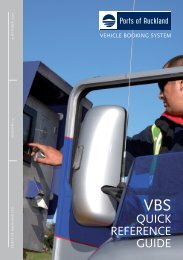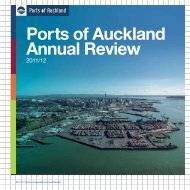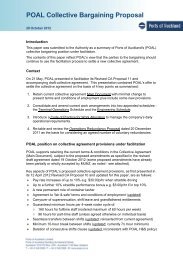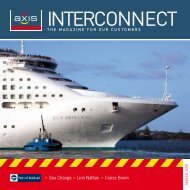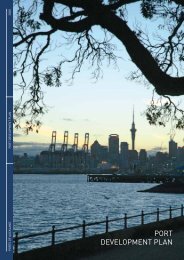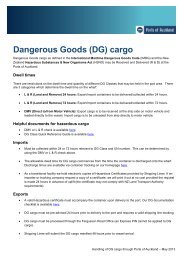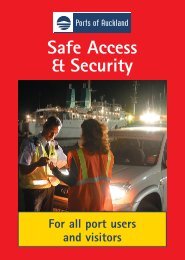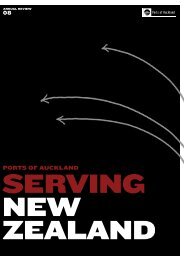ONE - Ports of Auckland
ONE - Ports of Auckland
ONE - Ports of Auckland
Create successful ePaper yourself
Turn your PDF publications into a flip-book with our unique Google optimized e-Paper software.
TELLING IT THE<br />
WAY IT WAS – SEEING<br />
IT THE WAY IT IS<br />
– and finally, the breakdown – <strong>of</strong> the<br />
Conference’s grip on the NZ cargo market.<br />
So it was through these NVOCC operations<br />
that the NZ freight forwarders came <strong>of</strong> age<br />
in ocean freight. They became acceptable to<br />
the carrier community in the sense that they<br />
were seen as valuable and legitimate<br />
customers. ’<br />
This is another big issue isn’t it? Who is the<br />
customer? With its historical focus on<br />
direct carrier/shipper relationships, the NZ<br />
shipping market is a bit different from<br />
others isn’t it?<br />
SF: ‘Traditionally in Europe shippers were<br />
more <strong>of</strong>ten than not, encouraged to use a<br />
freight forwarder – that was the way<br />
business was done. In NZ shipping services<br />
were started by the exporters themselves –<br />
primarily the meat and wool exporters – and<br />
so direct cargo owner/shipping line<br />
relationships developed and remained –<br />
albeit to a lesser extent than they used to.<br />
Exceptionally, the Union Steamship<br />
Company in the 1960s and 70s, followed the<br />
European way and encouraged customers to<br />
use four major forwarders/NVOCCs which<br />
were: Alltrans, brambles, Freightways and<br />
Mogal. They gained a strong hold on the<br />
market – not only on LCL cargo.<br />
Those NZ freight forwarders <strong>of</strong> 20 and 30<br />
years ago have now evolved into extremely<br />
efficient and powerful organisations that<br />
provide quality service for the cargo<br />
interests they look after. I believe that<br />
carriers and freight forwarders can have a<br />
valuable relationship in the current and<br />
future market.<br />
PORTS & CUSTOMERS<br />
At the same time we have another debate<br />
about the relationship <strong>of</strong> ports with their<br />
customers. Traditionally the ports have put<br />
the shipping lines as their primary customer.<br />
NOw wE SEE THE EMERGENCE OF dIRECT<br />
RELATIONSHIPS bETwEEN PORTS ANd<br />
CARGO OwNERS – wHICH I bELIEVE IS<br />
NECESSARy.<br />
The reality is that the ports have two levels<br />
<strong>of</strong> customer base they have to satisfy: 1) the<br />
carriers that control the movement <strong>of</strong> the<br />
containers port gate to ship/return. 2) the<br />
cargo owners who put the cargo into the<br />
containers. As I see it, the ports MUST<br />
engage with both groups – whether the<br />
carriers like it or not. Indeed, they did not<br />
like it at all when ports first started<br />
promoting themselves to major cargo<br />
interests whom the carriers regarded very<br />
much as their customers, their ‘property’.<br />
They didn’t like it because the ports started<br />
to influence the cargo owners on port choice.<br />
but the ports are commercial enterprises with<br />
massive investment and they must have<br />
involvement with the cargo interests – just as<br />
they did in the very beginning. After all, in the<br />
beginning, all the cargo owners (many <strong>of</strong><br />
whom were the ship owners or charterers as<br />
well) were the customers <strong>of</strong> the ports.<br />
Other major milestones: sophisticated IT<br />
systems represent the point <strong>of</strong> difference<br />
between shipping and ports industry<br />
companies today. These systems have taken<br />
transhipment from a dirty word to standard<br />
practice – a major breakthrough which owes<br />
its transformation largely to ports with quality<br />
IT and sophisticated transhipment systems to<br />
ensure that cargo moves smoothly and<br />
unimpeded across the wharves at their port.<br />
In return, transhipment for these ports is now<br />
a growing and important revenue stream.’<br />
07





